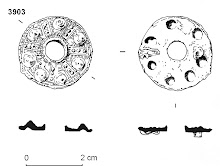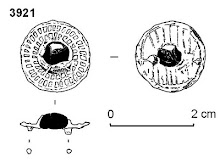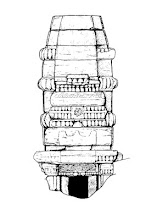
September and October 2009 saw Chiz working as site supervisor for English Heritage's Archaeological Projects up at
Birdoswald on Hadrian's Wall. The site was part of a cremation cemetery which was fast disapearing over the edge of a 300 foot cliff into the River Irthing so the plan was to excavate a strip along the cliff edge to get ahead of the erosion. The team was led by EH Project Manager Tony Wilmott.
Recording on site was using a digital system from Sweden called
Intrasis, which involves digital inputting of all data. This did cause some problems and issues, but given time and tweaking does have potential. The site also acted as a training excavation for a great bunch of archaeology students from Newcastle University under the direction of Professor Ian Haynes.
Numerous cremations were excavated, dating from the Hadrianic period onwards, with two possible 5th-century inhumation graves possibly relating to sub-Roman occupation of the fort. The cremation cemetery was contained by a small marker-ditch, parallel to a cobbled roadway, which had eroded into a hollow-way as it led downhill. The cremations were of various types, with possible bustum burials, as well as stone cysts and cobble lined cremation pits. Some cremations appear to have been marked by small ring ditches. No pyre sites were located, but areas of cobbled surface may indicate heavy use of some parts of the cemetery, possibly adjacent to pyres. Finds were fairly limited, although some pots were removed to Fort Cumberland for excavation in the lab, and initial x-rays suggest the presence of metal artefacts, including possibly fragments of chain mail.
Tony Wilmott's weekly site roundups can be read here.
Site accomodation was next to the Augustinian Priory at
Lanercost, a fantastic site and well worth a visit (photo above).
The Cricket club is also worth a visit.
 Roman small finds from Finsbury Circus, in the collections of the Museum of London; clockwise from top left:
Roman small finds from Finsbury Circus, in the collections of the Museum of London; clockwise from top left:


















